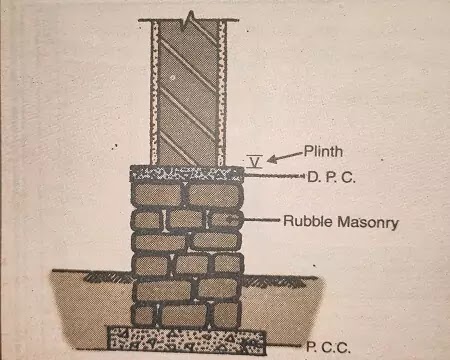The damp proofing course in the plinth is the seepage of water through the members of the building. There is very little difference between leakage and damp proof.
water comes out of the slab of the bathroom toilet. it is leakage and if the presence of the water is observed on external walls of the building directly exposed to rains and floors, then this percolation is damp proofing course in the plinth.
DAMP PROOFING COURSE IN PLINTH
- Foundation masonry is always in contact with the subsoil, which may contain water.
- This subsoil water tries to enter the building through the wall’s floors.
- Due to capillary action, this subsoil water sometimes rises into the walls of buildings, against gravity, and indicates dampness.
- Generally, foundation masonry is done with UC.R. Masonry, and at the plinth level, a damp proof course in the plinth course (D.P.C.) is provided to prevent capillary water of the subsoil water.
- The rich cement concrete, generally of M20 grade with water-proofing compound added to it, can be used as Damp proofing course in the plinth in buildings.
- Tar is also applied below this D.P.C., to prevent the entry of capillary action. Above the D.P.C., regular masonry for the superstructure is done.
CAUSES AND PRECAUTIONS FOR DAMPNESS IN WALLS
- If the foundation masonry is directly exposed to subsoil water, the water may enter the building through the walls.
- For this, ensure that pointing or plastering to the exposed walls is done, to restrict the direct contact of subsoil water with foundation masonry.
- Generally, the parapet masonry and the top floor masonry of the external walls are the worst affected by direct rains.
- During the masonry of such walls, ensure that quality masonry using rich mortar with the water-proofing compound is done.
- The hollow spaces and gaps should not remain in this masonry, as these are the routes for the water to enter.
- Plaster these walls with rich cement mortar containing waterproofing compounds.
 |
| damp proofing |
- Uninterrupted curing should be done to this plaster for avoiding the formation of any cracks.
- For the junctions of R.C.C. and masonry, the chicken mesh should be used before plastering.
- The terrace slab of the building should be projected 0.6m beyond the building should be along its periphery. This projection saves the topmost masonry of the wall from direct rainfall and reduces the chances of dampness.
- Dampness due to rain may occur on the wall, in the form of small or big circular spots.
- It is often observed that these spots are the locations where holes are made for the scaffolding of the external plastering and which are not treated properly afterward.
- Avoid such holes as far as possible and insist on M.S. scaffolding for the. plastering from outside.
- Dampness is also observed on the ceiling in the form of patches.
What is DPC ? Damp Proof course क्या होती है | Its Benefit & Uses
- It is due to the stagnant water on the terrace or some organic material dumped on the terrace.
- Ensure that during the execution of the terrace water-proofing work, a proper slope should be maintained, so that water does accumulateat any place.
- Keep the terrace clean during the rainy season to prevent continuous dampness, due to the presence of organic materials.
- The terrace slab concrete of the building should be cast carefully so that it attains density and impermeability.
- The possibility of any leakages through such dense concrete is almost nil.
MAJOR REMEDIES FOR THE DAMPNESS IN WALLS
Walls are the commonly affected portions of the building. The following sequence of remedial work should be observed during repairs.
- Check the external plaster of the walls where dampness has occurred.
- If any cracks are observed on the external plaster, break them open in V’ shape.
- Clean this V groove and apply the recommended primer to it.
- After drying the primer, fill these grooves with epoxy-based resins, such as M-Seal Tough Seal, etc.
- Apply a water-repellent solution over the painted area.
- If leakages still persist in the cracks of the wall, fill it up as discussed above.
Types of damp proof courses
-
The electro-osmotic damp proof course
-
The chemical damp proof course
-
Pressure grouting
-
Membrane damp proof course
-
The integral damp proof course
-
Cavity wall damp proof course
Also, Read This